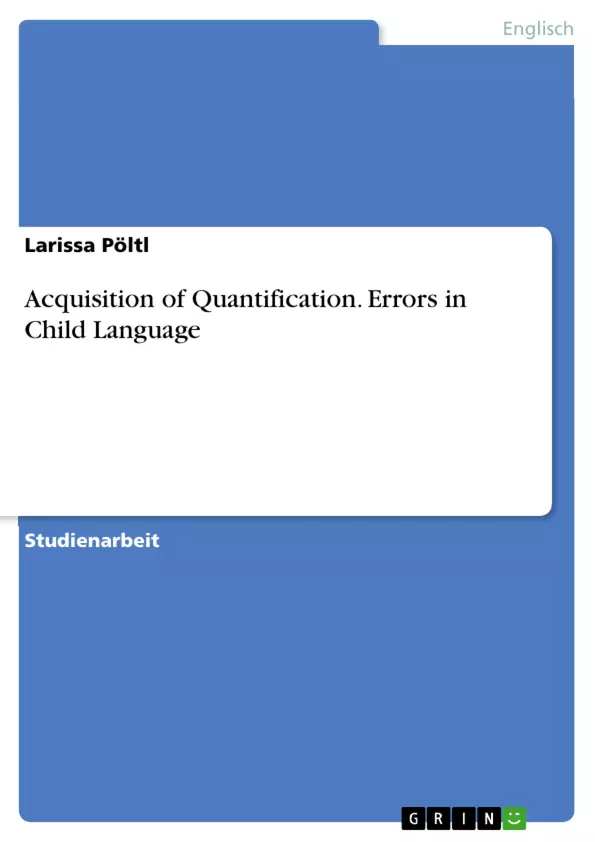The acquisition of quantifiers has always been a widely discussed topic in linguistics. Do children really have access to an adult interpretation from birth on or do they need to learn it throughout their childhood?
The main point hereby is that children seem to make a lot of mistakes while answering questions about quantification. They don’t seem to understand the meaning of every and all. These two quantifiers will be in the focus of this paper as well, because they are the most difficult ones and the ones where children make the most errors.
Some argue that children simply prefer a different interpretation than adults do or that they just have an inaccurate knowledge of the adult version. Others argue that children cannot distinguish part-whole relationships or that the position of the quantifier in the sentence is of importance. It could also be a parametric variation across languages. Often, linguists blame a wrong syntax to semantics mapping as well.
Inhaltsverzeichnis
- Introduction
- Quantifier Sentences and Prerequisites
- What Do Children Know?
- Errors in Child Language
- The Symmetrical Account
- Problems With The Symmetrical Account
- Experience-based Approach
- Felicity and Plausibility
- Conclusion
Zielsetzung und Themenschwerpunkte
Diese Arbeit befasst sich mit der Erwerbung von Quantifizierern in der Kindersprache und analysiert, wie Kinder mit Quantifizierer-Sätzen umgehen. Ziel ist es, die wichtigsten Fehler, die Kinder bei der Interpretation von Quantifizierern machen, zu untersuchen und zu erklären, welche Faktoren zu diesen Fehlern führen.
- Interpretation von Quantifizierern in der Kindersprache
- Fehlermuster bei der Interpretation von Quantifizierern
- Linguistische und nicht-linguistische Faktoren, die zu Fehlern führen
- Theorien zur Erklärung von Fehlern bei der Interpretation von Quantifizierern
- Die Rolle des symmetrischen Kontos, des Erfahrungsbasierten Ansatzes und der Plausibilitätsbedingungen
Zusammenfassung der Kapitel
- Introduction: Die Arbeit führt in das Thema der Quantifizierer-Erwerbung ein und beleuchtet die Problematik der Interpretation von Quantifizierern in der Kindersprache. Es werden die wichtigsten Fehlertypen und die verschiedenen Theorien zur Erklärung dieser Fehler vorgestellt.
- Quantifier Sentences and Prerequisites: Dieses Kapitel analysiert die verschiedenen Arten von Quantifizierer-Sätzen und die Voraussetzungen, die Kinder benötigen, um diese Sätze zu verstehen. Hierbei werden wichtige Konzepte wie Quantifier Raising (QR) und die Unterscheidung zwischen isomorphen und nicht-isomorphen Interpretationen erläutert.
- The Symmetrical Account: Dieses Kapitel stellt das symmetrische Konto vor, eine Theorie, die die Fehler von Kindern in Bezug auf Quantifizierer-Sätze mit der Annahme erklärt, dass Kinder Objekte symmetrisch wahrnehmen. Es werden die wichtigsten Argumente dieser Theorie und die Probleme, die während der Experimente auftraten, diskutiert.
Schlüsselwörter
Diese Arbeit befasst sich mit den zentralen Themen der Quantifizierer-Erwerbung, der Interpretation von Quantifizierer-Sätzen in der Kindersprache, dem symmetrischen Konto, dem Erfahrungsbasierten Ansatz, der Plausibilitätsbedingung und der Fehleranalyse in der Sprachentwicklung.
- Quote paper
- Larissa Pöltl (Author), 2013, Acquisition of Quantification. Errors in Child Language, Munich, GRIN Verlag, https://www.grin.com/document/339559



